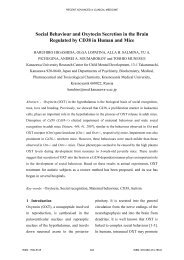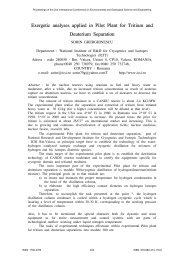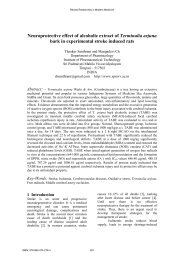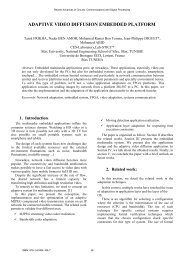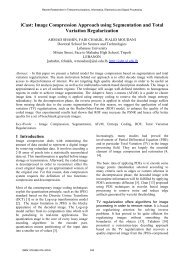The Matrix Padé Approximation in Systems of Differential ... - WSEAS
The Matrix Padé Approximation in Systems of Differential ... - WSEAS
The Matrix Padé Approximation in Systems of Differential ... - WSEAS
Create successful ePaper yourself
Turn your PDF publications into a flip-book with our unique Google optimized e-Paper software.
<strong>WSEAS</strong> TRANSACTIONS on MATHEMATICSC. Pestano-Gab<strong>in</strong>o, C. Gonz_Lez-Concepcion, M.C. Gil-Far<strong>in</strong>a<strong>The</strong> <strong>Matrix</strong> Padé <strong>Approximation</strong> <strong>in</strong> <strong>Systems</strong> <strong>of</strong> <strong>Differential</strong>Equations and Partial <strong>Differential</strong> EquationsC. PESTANO-GABINO, C. GONZΑLEZ-CONCEPCION, M.C. GIL-FARIÑADepartment <strong>of</strong> Applied Economics, University <strong>of</strong> La Laguna, 38071 La Laguna, SPAINcpestano@ull.es, cogonzal@ull.es, mgil@ull.esAbstract: In [3] we presented a technique to study the existence <strong>of</strong> rational solutions for systems <strong>of</strong> l<strong>in</strong>ear firstorderord<strong>in</strong>ary differential equations. <strong>The</strong> method is based on a rationality characterization that <strong>in</strong>volves <strong>Matrix</strong>Padé Approximants. Moreover the ma<strong>in</strong> ideas were only applied <strong>in</strong> the numerical resolution <strong>of</strong> a particularpartial differential equation. This paper may be considered as an extension <strong>of</strong> [3], <strong>in</strong> the sense that we proposefundamental matrices directly for l<strong>in</strong>ear m-order ord<strong>in</strong>ary differential equations without mak<strong>in</strong>g atransformation to an equivalent system <strong>of</strong> first order. In addition, we <strong>in</strong>crease its field <strong>of</strong> applications toparticular solutions <strong>of</strong> the mentioned systems and to Partial <strong>Differential</strong> Equations.Key-Words: <strong>Systems</strong> <strong>of</strong> <strong>Differential</strong> Equations, Partial <strong>Differential</strong> Equations (PDE), <strong>Matrix</strong> Padé<strong>Approximation</strong> (MPA), rational solutions, m<strong>in</strong>imum degrees (m.d.)AMS subject classification: 41A21, 34A45, 35A351 IntroductionWe will use the matrix notation <strong>in</strong> <strong>Systems</strong> <strong>of</strong> L<strong>in</strong>earm-Order Ord<strong>in</strong>ary <strong>Differential</strong> Equations as follows.Consider<strong>in</strong>g A j :D⊂ R → C mxn (j=1,2...m) andY:D⊂ R → C n+1 , letY (m (t)=A 1 (t) Y (m-1 (t)+A 2 (t) Y (m-2 (t)+…+A m-1 (t) Y'(t)+A m (t) Y(t) (1)be an homogeneous system <strong>of</strong> l<strong>in</strong>ear m-order ord<strong>in</strong>arydifferential equations.Normally, to resolve the system (1) we transform it<strong>in</strong>to an equivalent one <strong>of</strong> first order, by changes <strong>of</strong>variables. We will resolve it later but not mak<strong>in</strong>g use<strong>of</strong> that transformation.Def<strong>in</strong>ition 1: F(t) is a fundamental matrix <strong>of</strong> (1) if anysolution <strong>of</strong> (1) can be written as a l<strong>in</strong>ear comb<strong>in</strong>ation<strong>of</strong> the columns <strong>of</strong> F(t).Obta<strong>in</strong><strong>in</strong>g a fundamental matrix is essential to solvesystems <strong>of</strong> differential equations. However there is noprocedure to f<strong>in</strong>d it from any matrix functions A 1 (t),A 2 (t)...A m (t). In this paper we consider that theelements <strong>of</strong> the matrices are analytic functions. It is<strong>in</strong>terest<strong>in</strong>g to note that we do not take <strong>in</strong>to account thecircle <strong>of</strong> convergence <strong>of</strong> power series, when weconsider rational functions. What is important is toknow their poles ([3]).Proposition 1: If A 1 (t), A 2 (t)...A m (t) are cont<strong>in</strong>uousmatrix functions then (1) has a fundamental matrix <strong>of</strong>dimension n x nm.Pro<strong>of</strong>: <strong>The</strong> set <strong>of</strong> solutions for a homogeneous system<strong>of</strong> l<strong>in</strong>ear first-order ord<strong>in</strong>ary differential equations,X'(t)=A(t) X(t), with A(t) a cont<strong>in</strong>uous matrix function<strong>of</strong> order n, is a l<strong>in</strong>ear space <strong>of</strong> dimension n (it has afundamental matrix <strong>of</strong> dimension nxn) ([5]).By changes <strong>of</strong> variables (V i (t)=Y (i , i=1,2...m-1) wetransform (1) <strong>in</strong>to the equivalent system <strong>of</strong> first orderthat follows:⎛ 0 I 0 ⋯ 0 ⎞⎛ Y '(t) ⎞ ⎜⎟⎛ Y(t) ⎞⎜ 0 0 I 0' ⎟V1(t)⎜⋯ ⎟⎜ ⎟⎜ ⎟ V1(t)= ⎜ ⋮ ⋮ ⋮ ⋯ ⋮ ⎟⎜ ⎟⎜ ⋮ ⎟ ⎜⎟⎜ ⋮ ⎟⎜ ⎜ 0 0 0 I ⎟V (t) ⎟ ⋯ ⎜ V (t) ⎟⎝ ⎠ ⎝ ⎠'m−1 ⎜m−1Am(t) Am−1(t) Am−2(t) A1(t)⎟⎝⋯ ⎠g ) mij(t)i, j= 1Let G(t)= ((2), be a fundamental matrix for (2)such that G(0)=I nm x nm and g ij : D⊂ R → C nxn , i.e., thenm columns <strong>of</strong> G(t) constitute a base for the set <strong>of</strong>solutions <strong>of</strong> (2). Note that g ji (t)= ( j −g11i(t) , i.e., the j-throw <strong>of</strong> matrices <strong>in</strong> G(t) is the (j-1)-th derivative <strong>of</strong> thefirst row <strong>of</strong> matrices <strong>in</strong> G(t). Consider<strong>in</strong>g∞kg ij (t)= ∑ gijkt, we write the <strong>in</strong>itial conditionk=0G(0)=I nmxnm as follows:g 1ii-1 =I nxn and g 1ij =0 if j≠i-1, for i=1,2...m; j=0,1... m-1(3)Note that <strong>in</strong> (3) we consider only coefficients <strong>of</strong> g 1j (t),(j=1,2...m).Let S be the set <strong>of</strong> solutions <strong>of</strong> (1), the nm columns <strong>of</strong>F(t)≡(g 11 (t) g 12 (t) ... g 1m (t)) -with the condition (3)-constitute a base <strong>of</strong> the l<strong>in</strong>ear space S. Note that F(t) isa fundamental matrix <strong>of</strong> dimension n x nm <strong>of</strong> (1). ■kGiven the formal power series, A j (t)= ∑ Ajk(t − t0) ,∞k=0A jk ∈ C mxn for j=1,2...m,, we calculate recursively thecoefficients <strong>of</strong> the series for a fundamental matrix <strong>of</strong>ISSN: 1109-2769 344 Issue 6, Volume 7, June 2008
<strong>WSEAS</strong> TRANSACTIONS on MATHEMATICSC. Pestano-Gab<strong>in</strong>o, C. Gonz_Lez-Concepcion, M.C. Gil-Far<strong>in</strong>a∞k(1), F(t)= ∑ Fk(t − t0) , F k ∈ Cnxmn , as follows (withoutk=0consider<strong>in</strong>g the equivalent system <strong>of</strong> first-order).Substitut<strong>in</strong>gF (h (t)=∞∑k=0k(k + h)(k + h − 1)...(k + 1)F (t − t ) , h=1, 2...m,k+h 0<strong>in</strong> F (m (t)=A 1 (t)F (m-1 (t)+A 2 (t)F (m-2 (t)+ +A m-1 (t)F'(t)+A m (t)F(t). Later on, we will expla<strong>in</strong> moreexplicitly the recurrence relation for the specificexamples we are go<strong>in</strong>g to study.2 <strong>Matrix</strong> Padé Approximants andRational FunctionsOnce the formal power series for a fundamental matrix(or for a particular solution) is obta<strong>in</strong>ed, it is <strong>of</strong>practical <strong>in</strong>terest to get the theoretic functionassociated to the series. It is evident that this aim isunatta<strong>in</strong>able <strong>in</strong> general and it may only be obta<strong>in</strong> <strong>in</strong>certa<strong>in</strong> problems.In this section we will consider <strong>Matrix</strong> Padé<strong>Approximation</strong> (MPA) results to determ<strong>in</strong>e it there is arational solution and, if so, obta<strong>in</strong> m<strong>in</strong>imum degrees -<strong>in</strong> certa<strong>in</strong> sense- <strong>of</strong> the polynomials <strong>in</strong>volved.We denote as F any formal power series, with matrixcoefficients as follows:∞kmxnF(t) = fk t fk∈ tk=0∑ C ∈C (4)Suppose that there exist matrix polynomials:Q (z) =hhi∑bizi=0hiN h(z) = ∑n iz n ii=0Pg(z) =Dg(z) =g∑i=0g∑i=0ia izidizq ∈Cip ∈Ci∈Cdi∈Cmxnmxnnxnmxmpara i = 0,1,..,hpara i = 0,1,..,hpara i = 0,1,..,gpara i = 0,1,..,gwhere p 0 =I nxn , d 0 =I mxm , F(t)-Q h (t)P -1 g (t)=O(t h+g+1 ) andF(t)-D -1 g (t)N h (t)=O(t h+g+1 ), Q h P -1 g is therefore said to bea right <strong>Matrix</strong> Padé Approximant (right MPA) which isdenoted R [h/g] F ; similarly, D -1 g N h is said to be a left<strong>Matrix</strong> Padé Approximant (left MPA), which is denotedL [h/g] F . We shall use { L [h/g] F } ({ R [h/g] F }) to denote theset <strong>of</strong> all possible approximants L [h/g] F ( R [h/g] F ).As a consequence <strong>of</strong> the def<strong>in</strong>ition we can say that:* R [h/g] F exists, i.e., { R [h/g] F }≠∅, if and only if, thefollow<strong>in</strong>g system has a solution:f h-g+k p g +f h-g+k+1 p g-1 +...+f h+k-1 p 1 =-f h+k , k=1,2...g RS(h,g)* L [h/g] F exists, i.e., { L [h/g] F }≠∅, if and only if thefollow<strong>in</strong>g system can be solved:d g f h-g+k +d g-1 f h-g+k+1 +...+d 1 f h+k-1 =-f h+k k=1,2...g LS(h,g)In both cases it is assumed that f i =0, i0, letjM1( i, j) = ( f i− j+ h+ k− 1) h , k=1,LLM4 (i, j) = (f ) ,j,s+ r−isr i− j+ h+ k− 1 h,k=1M5 (i, j) = (f ) ,Rj+ 1,s+ r−isr i− j+ h+ k− 1 h,k=1M4 (i, j) = (f )s+ r−i,jsr i− j+ h+ k− 1 h,k=1M5 (i, j) = (f )R s+ r− i,j+1sr i− j+ h+ k− 1 h,k=1By convention, if j=0 the rank <strong>of</strong> these matrices is zer<strong>of</strong>or any i∈N.Def<strong>in</strong>ition 4: For any nonnegative <strong>in</strong>tegers i, j, letT1(i,j)=rank(M1(i,j)). We will display these quantities <strong>in</strong>an <strong>in</strong>f<strong>in</strong>ite two-dimensional table, Table 1, where i and jserve to enumerate the columns and the rowsrespectively.Def<strong>in</strong>ition 5: We def<strong>in</strong>e the staired block R1 to be thefollow<strong>in</strong>g subset <strong>of</strong> N 2 :R1={(i,j)∈ N 2 /rank(M1(g,h))=rank(M1(g+k,h+k)) forany k∈N, g≥i and h≥j}..ISSN: 1109-2769 345 Issue 6, Volume 7, June 2008
<strong>WSEAS</strong> TRANSACTIONS on MATHEMATICSC. Pestano-Gab<strong>in</strong>o, C. Gonz_Lez-Concepcion, M.C. Gil-Far<strong>in</strong>aAlthough this set seems rather abstract, the mean<strong>in</strong>g <strong>of</strong>"staired" becomes clear observ<strong>in</strong>g Tables 1 <strong>in</strong> examplesbelow.To beg<strong>in</strong> with, we can propose a method, us<strong>in</strong>g Table 1,to determ<strong>in</strong>e whether or not a matrix series stems from arational function. This can be set out as follows.2.1.1.1 RationalityF is rational if and only if <strong>in</strong> the bottom right part <strong>of</strong>Table 1 we can mark at least one NW-SE diagonal <strong>of</strong><strong>in</strong>f<strong>in</strong>ite size where all its boxes have the same value. It isimportant to state that, there are several such diagonals,with their union co<strong>in</strong>cid<strong>in</strong>g with R1. Note that, with<strong>in</strong>R1, boxes <strong>of</strong> different diagonals can have differentvalues. Furthermore, it is assured that if (a,b)∈R1 thenthe formal power series <strong>of</strong> F and [a/b] F is the same.However, (a,b) are not necessarily left or right m.d.In practice, the Table 1 that we can construct is "f<strong>in</strong>ite".However, <strong>in</strong> some applications where a rule for theformation <strong>of</strong> the coefficients <strong>of</strong> the series F is known,certa<strong>in</strong> relations between the matrices that def<strong>in</strong>e theelements <strong>of</strong> Table 1 can help validate the properties toan <strong>in</strong>f<strong>in</strong>ite size. Otherwise, we can only say the availablecoefficients <strong>of</strong> F co<strong>in</strong>cide with the coefficients <strong>of</strong> arational function <strong>of</strong> certa<strong>in</strong> degrees.2.1.1.2 M<strong>in</strong>imality<strong>The</strong> boxes (i,j) such that T1(i,j)∈R1, T1(i-1,j)∉R1 andT1(i,j-1)∉R1 are called corners <strong>of</strong> R1. In particularsituations we can say that a corner <strong>of</strong> R1 correspondswith a pair <strong>of</strong> left or right m.d., for <strong>in</strong>stance:Property 1: If (i,j)∈R1, (i-1,j)∉R1 and T1(i,j)=jn then(i-u,j-v) is not a pair <strong>of</strong> right m.d. for any u, v such that1≤u≤i and 0≤v≤j.Property 2: If (i,j)∈R1, (i-u,j)∉R1, (i,j-v)∉R1, for anyu, v such that 1≤u≤i and 1≤v≤j, and they are not pairs <strong>of</strong>left (right) m.d., then (i,j) is a pair <strong>of</strong> left (right) m.d.2.1.2 Table 2: M<strong>in</strong>imalityIf F is rational, there are (and we can f<strong>in</strong>d) certa<strong>in</strong>degrees r and s associated to two pairs <strong>of</strong> matrixpolynomials which represent the function <strong>in</strong> rationalform <strong>in</strong> two ways, that is to say, with the <strong>in</strong>vertedpolynomial <strong>of</strong> degree r, multiplied to the right or left.However, it may be that r and s are neither left nor rightm.d. for represent<strong>in</strong>g F s<strong>in</strong>ce there are cases <strong>in</strong> which,for <strong>in</strong>stance, the function is identical to an approximantL [i/j] F but the approximant R [i/j] F does not exist, orviceversa; <strong>in</strong> this case, rank(M1(i,j))≠rank(M1(i+1,j+1))and thus Table 1 would not provide <strong>in</strong>formationconcern<strong>in</strong>g the left or right approximant. For this reason,we present Table 2 -one for the left and one for the rightapproximant-, whose structure reflects the possiblecomb<strong>in</strong>ations <strong>of</strong> m.d. (left and right, respectively) forrepresent<strong>in</strong>g F.Firstly we present the follow<strong>in</strong>g def<strong>in</strong>itions.Def<strong>in</strong>ition 6: Given (s,r)∈R1, for <strong>in</strong>teger i, j, such that0≤i≤s and 0≤j≤r, let L T2 sr (i,j)=0, if rank( L M4 sr (i,j))=rank( L M5 sr (i,j)), or otherwise L T2 sr (i,j)=1. We willdisplay these quantities <strong>in</strong> a f<strong>in</strong>ite two-dimensional table,Table 2 for left approximant, which has s+1 columnsand r+1 rows.Def<strong>in</strong>ition 7: We denote as a staired block L R2 sr , with(s,r)∈R1, the follow<strong>in</strong>g subset <strong>of</strong> N 2 :L R2 sr ={(i,j)∈ N 2 /0≤i≤s, 0≤j≤r andrank( L M4 sr (i,j))=rank( L M5 sr (i,j))}.To def<strong>in</strong>e Table 2 for right approximant we mustconsider R M4 sr (i,j) and R M5 sr (i,j) <strong>in</strong>stead <strong>of</strong> L M4 sr (i,j) andL M5 sr (i,j), respectively. We only expound the theory forthe left case tak<strong>in</strong>g <strong>in</strong>to account that for the right case itis similar.Property 3: F is a rational function identical to L [q/p] Fwhere q and p are left m.d., q≤s and p≤r, if and only if,L T2 sr (q,p)=0, L T2 sr (q-1,p)=1 and L T2 sr (q,p-1)=1, that is,(q,p) is a corner <strong>of</strong> L R2 sr .<strong>The</strong> system correspond<strong>in</strong>g to the denom<strong>in</strong>ator <strong>of</strong> theelement <strong>of</strong> { L [q/p] F } that co<strong>in</strong>cides with F is:d p f q-p+i +d p-1 f q-p+i+1 +...+d 1 f q+i-1 =-f q+i i=1,2...s+r-qwhose associated matrix is L M4 sr (q,p).<strong>The</strong>n we will consider the results <strong>of</strong> MPA to studypossible rational solutions <strong>of</strong> differential equationssystems and <strong>of</strong> partial differential equations.3 Rational Solutions for <strong>Systems</strong> <strong>of</strong>Ord<strong>in</strong>ary <strong>Differential</strong> EquationsIn order to obta<strong>in</strong> a clear understand<strong>in</strong>g, it is importantto read the follow<strong>in</strong>g remarks relat<strong>in</strong>g to possiblerational solutions <strong>of</strong> the system (1).- Even if A 1 (t), A 2 (t)...A m (t) are not rational there mayexist rational solutions. For <strong>in</strong>stance, the systemtt⎛ e − e + 2 ⎞⎜⎟Y'(t)= ⎜ 2t + 4 2t + 4 ⎟ Y(t)s<strong>in</strong>t − s<strong>in</strong> t + 2⎜⎟⎝ 2t + 4 2t + 4 ⎠⎛has a rational solution, Y(t)= 2t + 4 ⎞⎜ ⎟⎝ 2t + 4.⎠- <strong>The</strong> fact that there exists rational solution does notimply the fundamental matrix is rational. Note thatgenerally the l<strong>in</strong>ear comb<strong>in</strong>ation <strong>of</strong> no rationalfunctions could be a rational function, for <strong>in</strong>stance, ifx(t)= cos t−and y(t)= 2cos t + 8 the l<strong>in</strong>ear3t − 23t − 216comb<strong>in</strong>ation 4x(t)+2y(t) is the rational function3t − 2.- <strong>The</strong> system (1) may have a fundamental matrix withISSN: 1109-2769 346 Issue 6, Volume 7, June 2008
<strong>WSEAS</strong> TRANSACTIONS on MATHEMATICSC. Pestano-Gab<strong>in</strong>o, C. Gonz_Lez-Concepcion, M.C. Gil-Far<strong>in</strong>asome rational elements and others which are not. Nextwe proceed to illustrate different cases.Our aim <strong>in</strong> this section is to detect rationalfundamental matrices (which are rectangular when theorder <strong>of</strong> the system is greater than 1). In other case, ifthis is not possible, then to detect particular rationalcolumns or particular rational solutions. If F(t) isrational then any solution <strong>of</strong> (1) is rational comply<strong>in</strong>gwith the aims. However, when F(t) is not rational andis <strong>in</strong> analytical form it would be <strong>in</strong>terest<strong>in</strong>g to know ifthere exist any <strong>in</strong>itial conditions, such that theassociated particular solution to be rational. It is noteasy to f<strong>in</strong>d the answer to this question <strong>in</strong> generalcases.We start with an example where the fundamentalmatrix is not rational but the system does have rationalsolutions.Example 1. Let Y''(t)=C(t) Y(t) be a differential2⎛ 1 t + 2 ⎞⎜ 2 3 ⎟(2 t) (2 t)system where C(t)= ⎜ − − ⎟ . Consider<strong>in</strong>g⎜24t − 8 6t ⎟⎜2 3 2 2(t + 2) (t + 2)⎟⎝⎠C(t)=∞∑i=0C tii, we obta<strong>in</strong> recursively the coefficients <strong>of</strong>the series for a fundamental matrix F(t)=follows:∞ ∞ ∞i i i+ +i+2=i ii= 0 i= 0 i=0∞∑i=0F tii∑(i 2)(i 1)F t ( ∑C t )( ∑ F t )(5)⎛<strong>The</strong>n, tak<strong>in</strong>g <strong>in</strong>to account (3), F 0 = 0 0 1 0 ⎞⎜ ⎟⎝0 0 0 1and⎠⎛F 1 = 1 0 0 0 ⎞⎜ ⎟ , and consider<strong>in</strong>g (5) we calculate the⎝0 1 0 0⎠ other coefficients us<strong>in</strong>g the follow<strong>in</strong>g expression:F i+2 =( ∑ i CjF i−j) /(i + 2)(i + 1) , i≥0 (6)j=0Fig. 1: Table 1 for F(t)0 1 2 3 4 50 0 0 0 0 0 01 2 2 2 2 2 22 4 4 4 4 4 43 6 6 6 6 6 64 8 8 8 8 8 85 10 10 10 10 10 10Note that F(t) is not rational <strong>of</strong> orders (p,q) such that0≤p
<strong>WSEAS</strong> TRANSACTIONS on MATHEMATICSC. Pestano-Gab<strong>in</strong>o, C. Gonz_Lez-Concepcion, M.C. Gil-Far<strong>in</strong>aw j (x)= 2 sen πjx. In this case, the equation (10) <strong>in</strong>matrix form is:V'(t)=A(t) V(t) (11)where V(t) = (v 1 (t) v 2 (t) ... v n (t)) t and A(t) is an nxnmatrix which elements are:3 'a ij (t)= w2 j, wi.2(4 + t )Consider<strong>in</strong>g the <strong>in</strong>itial conditions, we have:n∑ vj(0)w j(x)= s<strong>in</strong> 2πx. Due to the fact thatj=1{w 1 ,w 2 ...w n } is an ortonormal system, then:v j (0)= s<strong>in</strong> 2π x, wj(j=1...n) (12)<strong>The</strong> expression (12) provides <strong>in</strong>itial conditions forsystem (11).To illustrate the procedure, suppose that n=2 <strong>in</strong> (8).Obviously, with greater n we obta<strong>in</strong> betterapproximation.1 ⎛0 −1⎞If n=2, then A(t)=2 ⎜ ⎟t 1 0. Consider<strong>in</strong>g1+⎝ ⎠4A(t)=∞∑j= 0jA jtj⎛ ⎛ 1 ⎞⎜ 0 ⎜ ⎟ ( −1)4A 2j =⎜ ⎝ ⎠⎜ j⎛ −1⎞⎜⎜⎟ 0⎝⎝4 ⎠, we have that A 2j+1 =0,j+1A fundamental matrix F(t)=such that F 0 =I, verifies thatk1F k+1 = ∑ AjFk − jk≥0k + 1j=0⎞⎟⎟⎟for j=0,1,2...⎟⎠Fig. 7: Table 1 for F(t)0 1 2 3 4 50 0 0 0 0 0 01 2 2 2 2 2 22 4 4 2 2 2 23 6 6 4 2 2 24 8 8 6 4 2 25 10 10 8 6 4 2∞j∑ Fjt<strong>of</strong> the system (11)j=0It <strong>in</strong>dicates that F(t)=[1/1] F . Solv<strong>in</strong>g the systemLS(1,1), and calculat<strong>in</strong>g the numerator, F(t) can berepresented as follows:⎡⎛1 0⎞ ⎛ 0 1/ 2⎞ ⎤ ⎡⎛1 0⎞ ⎛ 0 −1/ 2⎞⎤F(t) = ⎢⎜ ⎟ + ⎜ ⎟ t⎥ ⎢⎜ ⎟ + ⎜ ⎟ t⎥⎣⎝0 1⎠ ⎝ −1/ 2 0 ⎠ ⎦ ⎣⎝0 1⎠ ⎝1/ 2 0 ⎠ ⎦2⎛ t ⎞1 t1⎜ − − ⎟or equivalently F(t)= ⎜ 4 ⎟ .2 2t ⎜ t ⎟1+ t 1−4⎜⎟⎝ 4 ⎠Given <strong>in</strong>itial conditions, we calculate the particular−1solution V(t)=F(t)K, where K∈ R 2 . Note that V(0)=K.⎛ 0 ⎞Tak<strong>in</strong>g <strong>in</strong>to account (12), K=⎜1/ 2 ⎟. <strong>The</strong>refore,⎝ ⎠⎛ −t⎞1V(t)= ⎜ 2 ⎟2 t andt 1−2(1 + ) ⎜ ⎟⎝ 4 ⎠42t−t s<strong>in</strong> π x + (1 − )s<strong>in</strong> 2πxu(x,t)=4 .2t1+4In the case that we are <strong>in</strong>terested only <strong>in</strong> a particularsolution that verifies certa<strong>in</strong> <strong>in</strong>itial conditions, it is notnecessary to calculate a fundamental matrix. To know∞⎛ 0 ⎞jV(t), we suppose that V(t)= ∑ Vjt, with V 0 =⎜j=01/ 2 ⎟.⎝ ⎠k1<strong>The</strong>n se V k+1 = ∑ AjVk − j, k≥0.k + 1j=0Fig. 8: Table 1 for V(t)0 1 2 3 4 50 0 0 0 0 0 01 1 1 1 1 1 12 2 2 2 2 2 23 3 3 3 2 2 24 4 4 4 3 2 25 5 5 5 4 3 2This table <strong>in</strong>dicates that V can be represented as leftand right approximants <strong>of</strong> the set {[2/2] V }.Consider<strong>in</strong>g right approximant, Table 2 is notnecessary because <strong>in</strong> Table 1 we can see taht (2,2) is apair <strong>of</strong> right m.d. (tak<strong>in</strong>g <strong>in</strong>to account Properties 1 and2 and T1(2,2)=2). We solve the system RS(2,2) to⎛ −t / 2 ⎞⎜ ⎟ 1obta<strong>in</strong> the known solution V(t)= 2⎜ 1 t ⎟ .2⎜ − ⎟t⎝ 2 4 2 ⎠(1 + )4Out <strong>of</strong> curiosity we have calculated the Table 2 for leftapproximant <strong>in</strong> fig. 9.Fig. 9: Table 2 for left approximant0 1 20 1 1 11 1 0 02 0 0 0It <strong>in</strong>dicates that (0,2) and (1,1) are two pairs <strong>of</strong> leftm.d.Let us consider the follow<strong>in</strong>g example. In this case weneed to solve a system <strong>of</strong> first order ord<strong>in</strong>arydifferential equations, V''(t)=A(t) V(t) where A(t) is adiagonal matrix, then each equation can be solve<strong>in</strong>dividually. <strong>The</strong>refore, <strong>in</strong>stead <strong>of</strong> MPA we will usescalar Padé approximation.ISSN: 1109-2769 349 Issue 6, Volume 7, June 2008
<strong>WSEAS</strong> TRANSACTIONS on MATHEMATICSC. Pestano-Gab<strong>in</strong>o, C. Gonz_Lez-Concepcion, M.C. Gil-Far<strong>in</strong>aExample 4Let it be the follow<strong>in</strong>g elliptic equation:2u tt = − u2 2 xx , t>0, t≠1, 0≤x≤1π (1 − t)u(0,t)=u(1,t)=0; u(x,0)=u t (x,0)=s<strong>in</strong>πxWe propose a solution <strong>of</strong> the form u(x,t)= 2 vj(t)w j(x)consider<strong>in</strong>g the same ortonormal system <strong>of</strong> Example 3.Substitut<strong>in</strong>g <strong>in</strong> the partial differential equation anddivid<strong>in</strong>g by 2 ), we obta<strong>in</strong>:'' 22v1(t)s<strong>in</strong> π x+ v2 2 1(t)( −π s<strong>in</strong> π x) +π (1−t)'' 22v2(t)s<strong>in</strong>2π x + v2 2 2(t)( −4π s<strong>in</strong>2π x) = 0π (1 −t)'' 2'' 8<strong>The</strong>n, v1(t)= v2 1(t), v2(t) = v2 2(t)(1 − t)(1 − t)We have two <strong>in</strong>dependent equations. Note that A(t) isa diagonal matrix.<strong>The</strong> <strong>in</strong>itial conditions can be deduced by:u(x,0)=v 1 (0)w 1 (x)+v 2 (0)w 2 (x)=s<strong>in</strong> πx, therefore,v 2 (0)=0 and v 1 (0)= 1 2 ,∑j=1u t (x,0)= v ' (0)w (x) + v ' (0)w (x) = s<strong>in</strong> π x , therefore,''2 11 1 2 2v (0) = 0 and v (0) =Consider<strong>in</strong>g the first equation122v (t) =(1 − t)v (t)''1 2 1andits conditions v 1 (0)= 1 2 and ' 1v1(0)= , we denote2the general solution as s(t)=∞i∑ siti=0. Tak<strong>in</strong>g <strong>in</strong>to account∞2jthat = 2 (j 1)t2 ∑ + -<strong>in</strong> the circle <strong>of</strong> convergence(1 − t) j=0<strong>of</strong> the series-. Substitut<strong>in</strong>g <strong>in</strong> the differential equationwe obta<strong>in</strong>:∞ ∞ ∞i i i∑ + +i+2= ∑ + ∑ ii= 0 i= 0 i=0(i 2)(i 1)s t 2( (i 1)t )( s t )<strong>The</strong>refore, to calculate the coefficients <strong>of</strong> the series s(t)we use the follow<strong>in</strong>g recurrence relation:is i+2 = 2( ∑ (j+ 1)si−j) /((i + 2)(i + 1)) i≥0.j=0Fig. 10: Table 1 for v 1 (t)0 1 2 3 4 50 0 0 0 0 0 01 1 1 1 1 1 12 2 1 1 1 1 13 3 2 1 1 1 14 4 3 2 1 1 15 5 4 3 2 1 1It shows that v 1 (t)=[0/1] s . Solv<strong>in</strong>g Padé equations for[0/1] s , v 1 (t)= 1/ 2 . In a similar way, solv<strong>in</strong>g1−t'' 8v2(t) = v2 2(t) , v 2 (0)= v ' 2(0) = 0 , we obta<strong>in</strong>(1 − t)v 2 (t)=0. <strong>The</strong>refore, the solution <strong>of</strong> the partialdifferential equation is: u(x,t)= 1 s<strong>in</strong> πx.1−t4.2 Method <strong>of</strong> F<strong>in</strong>ite Differences and MPAWe give the theory for the follow<strong>in</strong>g hyperbolic partialdifferential equation (generalized wave equation):u tt =α 2 (x,t) u xx 0≤x≤1, t>0u(0,t)=f 1 (t), u(1,t)=f 2 (t); u(x,0)=g 1 (x), u t (x,0)=g 2 (x)In this method we choose n∈N, calculate h=1/n andconsider the po<strong>in</strong>ts (x i ,t) where x i =ih for i=0,1,2...n.Note that we do not discretise variable t.Substitut<strong>in</strong>g these po<strong>in</strong>ts, for i=1...n-1, we obta<strong>in</strong>u tt (x i ,t) = α 2 (x i ,t) u xx (x i ,t). If we replace second partialderivative u xx with second differences we obta<strong>in</strong>:u tt (x i ,t)=α 2 u(xi+ 1, t) − 2u(xi, t) + u(xi−1, t)(x i ,t) u2xx (x i ,t),hfor i=1...n-1Denot<strong>in</strong>g2⎛ α (x1, t)f1(t)⎞⎜2 ⎟⎛ u(x1, t) ⎞ ⎜ h ⎟⎜ ⎟ ⎜ 0 ⎟u(x2, t)Y(t)= ⎜ ⎟ ⎜⎟, b(t)=⎜ ⋮ ⎟ ⎜⋮⎟and⎜ ⎟ ⎜ 0 ⎟⎝ u(xn−1, t) ⎠ ⎜⎟2α (xn−1, t)f2(t)⎜2 ⎟⎝ h ⎠2 2⎛−2 α (x,t)1α (x,t)10 ⋯ 0 ⎞⎜ 2 2 2⎟(x2,t) 2 (x2,t) (x2,t) 01⎜ α − α α ⋯⎟2 2A(t)= ⎜20 α (x3,t) −2 α(x 3,t) ⋯ 0 ⎟,h ⎜⎟⎜ ⋯ ⋯ ⋯ ⋯ ⋯ ⎟⎜2 20 0 α (xn−1 ,t) −2 α (xn−1,t) ⎟⎝⋯⎠we obta<strong>in</strong> the system <strong>of</strong> l<strong>in</strong>ear second-order ord<strong>in</strong>arydifferential equations:Y''(t)=A(t) Y(t)+b(t) (13)Note that the solution vector Y(t) is <strong>of</strong> dimension n-1.<strong>The</strong> <strong>in</strong>itial conditions for this system are:⎛ g1(x 1)⎞ ⎛ g2(x1)⎞⎜ ⎟ ⎜ ⎟g1(x 2)Y(0)= ⎜ ⎟ , Y'(0)= ⎜g2(x2)⎟⎜ ⋮ ⎟ ⎜ ⋮ ⎟⎜ ⎟ ⎜ ⎟⎝g 1(x n−1)⎠ ⎝g 2(xn−1)⎠Let us suppose Y(t)=∞∞∑i=0iY (t − t ) , A(t)=i 0∞∑i=0iA (t − t )i 0iand b(t)= ∑ bi(t − t0) where the coefficients <strong>of</strong> thesei=0series have suitable dimensions. Substitut<strong>in</strong>g <strong>in</strong> (13),the expression to calculate the coefficients <strong>of</strong> aISSN: 1109-2769 350 Issue 6, Volume 7, June 2008
<strong>WSEAS</strong> TRANSACTIONS on MATHEMATICSC. Pestano-Gab<strong>in</strong>o, C. Gonz_Lez-Concepcion, M.C. Gil-Far<strong>in</strong>aparticular solution, given the <strong>in</strong>itial conditions Y 0 andiY 1 , is Yi+ 2= ( ∑ AjYi − j+ bi) /((i + 2)(i + 1)) i≥0.j=0It is <strong>in</strong>terest<strong>in</strong>g to comment that, from computationalpo<strong>in</strong>t <strong>of</strong> view, if n is large h is very small and Y i<strong>in</strong>creases considerably when i <strong>in</strong>creases. To avoiderrors, we consider the formal power series∞* i∑ Yit ,i=0* 2iwith Yi= h Yi. Note that Y(t) is rational if and only ifY * (t) is rational.Let us study some particular examples.Example 52xu tt = u2t(1 − t)xx0≤x≤1, t>0, t≠0, t≠1u(0,t)=0 u(1,t)= t1− t; u(x,0.5)=x2 u t (x,0.5)=4x 2Consider<strong>in</strong>g, for <strong>in</strong>stance, n=10 and t 0 =0.5 (theequation has not sense <strong>in</strong> t=0) the <strong>in</strong>itial conditionsare:22⎛ x ⎞⎛1x ⎞1⎜ 2 ⎟⎜ 2 ⎟x2Y(0.5)= ⎜ ⎟ , Y'(0.5)=4 ⎜ x2⎟⎜ ⋮ ⎟⎜ ⋮ ⎟⎜2x ⎟⎜2⎝ 9 ⎠x ⎟⎝ 9 ⎠⎛ −2x x 0 ⋯ 02 21 1⎜ 2 2 22 2 2a⎜ −i 2 2i= ⎜23−3x 2x x ⋯ 0A 0 x 2x ⋯ 0h ⎜⎜ ⋯ ⋯ ⋯ ⋯ ⋯⎜⎝ 0 0 ⋯ x −2xwhere a 2i =2 2i+3 (i+1), a 2i+1 =2 2i+4 (i+1)⎛ 0 ⎞b i = i +⎜ ⎟2 2 (i + 2)(i + 1) ⎜⋮ ⎟ , i≥0.2h ⎜ 0 ⎟⎜ 2 ⎟⎝ x9⎠2 29 9⎞⎟⎟⎟⎟⎟⎟⎠Fig. 11: Table 1 for Y(t) is:0 1 2 3 4 50 0 0 0 0 0 01 1 1 1 1 1 12 2 2 1 1 1 13 3 3 2 1 1 14 4 4 3 2 1 15 5 5 4 3 2 1It <strong>in</strong>dicates that Y(t)=[1/1] Y . Solv<strong>in</strong>g the systemRS(1,1), we obta<strong>in</strong>⎛ 0.01+ 0.02(t − 0.5) ⎞⎜⎟Y(t)= R 0.04 0.08(t 0.5) 1[1/1] Y = ⎜+ −⎟⎜ ⋮ ⎟1− 2(t − 0.5)⎜⎟⎝ 0.81+ 1.62(t − 0.5) ⎠⎛ 0.01t ⎞⎜ ⎟0.04t 1which can be simplified as Y(t)= ⎜ ⎟⎜ ⋮ ⎟1−t⎜ ⎟⎝ 0.81t ⎠xNote that u(x,t)= 2 tis the solution and that Y(t)1−tco<strong>in</strong>cides with u(x,t) discretised <strong>in</strong> x.Example 6Let us see now an example where left approximant ismore suitable (left m.d. are smaller than right m.d.).2xu tt = u2 xxt>0, 0≤x≤1(1 + t)u(0,t)=1, u(1,t)= 12 + t; u(x,0)= 11+ x, u xt(x,0)= −2(1 + x)Consider<strong>in</strong>g different values <strong>of</strong> n (n=5, n=10, n=50) <strong>in</strong>this example Table 1 is highly sensitive to thethreshold that we choose to decide whether andelement is to be considered zero or not (Due to thelimitations <strong>of</strong> f<strong>in</strong>ite arithmetic, certa<strong>in</strong> theoretically zeroelements will not be exactly zeros, which is why wehave chosen a threshold so that any number with anabsolute value <strong>of</strong> below it will be considered as be<strong>in</strong>gzero). However Table 2 for left approximant, <strong>in</strong> mostcases, shows that (0,1) is a pair <strong>of</strong> left m.d.1Note that u(x,t)= is the solution and that1+ x(t + 1)Table 2 <strong>in</strong>dicates that Y(t)∈{ L [0/1] Y }. For <strong>in</strong>stance, ifn=5:Y(t) =⎛⎛1 0 0 0⎞ ⎛0.2 /1.2 0 0 0 ⎞ ⎞ ⎛1/1.2⎞⎜⎜ ⎟ ⎜ ⎟ ⎟ ⎜ ⎟⎜⎜ 0 1 0 0⎟0 0.4/1.4 0 0 1/1.4+ ⎜ ⎟ t⎟ ⎜ ⎟⎜⎜0 0 1 0⎟ ⎜ 0 0 0.6/1.6 0 ⎟ ⎟ ⎜1/1.6⎟⎜⎜ ⎟ ⎜ ⎟ ⎜ ⎟0 0 0 1 0 0 0 0.8/1.8 ⎟⎝⎝ ⎠ ⎝ ⎠ ⎠ ⎝1/1.8⎠i.e.; Y(t)=⎛ 1 ⎞⎜1 0.2(t 1)⎟⎜+ +⎟⎜ 1 ⎟⎜⎟⎜1+ 0.4(t + 1) ⎟⎜ 1 ⎟⎜⎟⎜1+ 0.6(t + 1) ⎟⎜ 1 ⎟⎜1+ 0.8(t + 1) ⎟⎝⎠is u(x,t) discretised <strong>in</strong> x.5 ConclusionsIn this paper we have extended results and practice <strong>of</strong>[3]. Our aim has been to highlight methods <strong>of</strong> look<strong>in</strong>gfor rational fundamental matrices for systems <strong>of</strong> l<strong>in</strong>earm-order differential equation and particular rationalsolutions for these systems and for partial differentialequations.−1ISSN: 1109-2769 351 Issue 6, Volume 7, June 2008
<strong>WSEAS</strong> TRANSACTIONS on MATHEMATICSC. Pestano-Gab<strong>in</strong>o, C. Gonz_Lez-Concepcion, M.C. Gil-Far<strong>in</strong>a<strong>The</strong> balanced use <strong>of</strong> numerical methods, together withapproximation theory is a very <strong>in</strong>terest<strong>in</strong>g alternativeto improve the calculation <strong>of</strong> these solutions (or,alternatively, approximated solutions).In this paper we comb<strong>in</strong>e Galerk<strong>in</strong> and F<strong>in</strong>iteDifference methods with MPA.Other applications were considered <strong>in</strong> [7] <strong>in</strong>connection with time series analysis and economicmodels.References[1] Burden, R.L. and Faires, J.D. Análisis Numérico.Grupo Editorial Iberoamιrica. México, 1996.[2] A. Draux, On the Non-Normal Padé Table <strong>in</strong> aNon-Conmutative Algebra, Journal <strong>of</strong> Computationaland Applied Mathematics 21, 1998, pp. 271-288.[3] González-Concepción, C. and Pestano-Gab<strong>in</strong>o, C.(1999), Approximated solutions <strong>in</strong> rational form forsystems <strong>of</strong> differential equations, NumericalAlgorithms 21, 185-203.[4] K<strong>in</strong>caid, D. and Cheney, W. Análisis Numérico.Addison-Wesley Iberoamericana. Argent<strong>in</strong>a, 1994.[5] Marcellαn, F., Casasϊs, L. and Zarzo, A. EcuacionesDiferenciales. Problemas l<strong>in</strong>eales y aplicaciones.McGraw-Hill. Madrid, 1990.[6] Pestano C. and González C. <strong>Matrix</strong> Padé<strong>Approximation</strong> <strong>of</strong> Rational Functions, NumericalAlgorithms, 15 (1997), 1-26.[7] Pestano-Gab<strong>in</strong>o, C. and González-Concepción, C.,Rationality, m<strong>in</strong>imality and uniqueness <strong>of</strong>representation <strong>of</strong> matrix formal power series, Journal<strong>of</strong> Computational an Applied Mathematics, 94 (1998),23-38.ISSN: 1109-2769 352 Issue 6, Volume 7, June 2008




